American Treasure: The French Lick Resort
Words: MASONRY Magazine
Photos: MASONRY Magazine, Ian McSpadden
When someone says “French Lick,” it doesn’t necessarily make you think of a beautiful and historic resort in rural Indiana, unless you are a Larry Bird fan of course. But in the quaint city of French Lick, Indiana there is a beautiful resort with tons of history and many sights to see. Once known as the French Lick Springs Hotel, the direct rival of the neighboring city, West Baden, Indiana. French Lick and West Baden are only five minutes from each other, they are so close you could miss the city limits.
In this month’s installation of our American Treasures series, we are taking you on an editorial trip through the French Lick Resort, which is made up of two large hotels. Not only is this hidden gem located in Indiana, but it is also the location of this year’s MCAA Midyear Meeting. We hope you enjoy this American Treasure as much as we enjoyed learning about it.
The Origins of French Lick
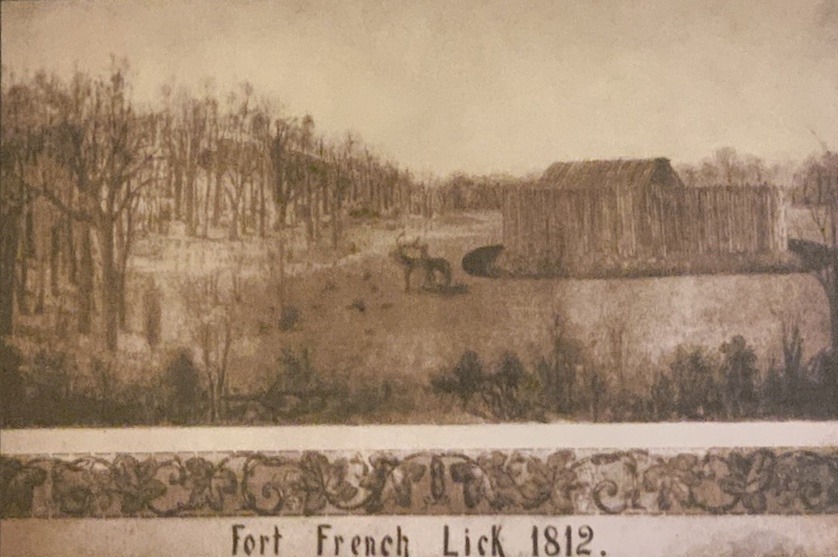
Just 50 miles Northwest of Louisville, Kentucky, French Lick Indiana was founded in 1811 and was a settlement named for an 18th-century French trading post in the area, which was near a spring and salt lick, according to the Britannica Encyclopedia. The term “lick” in the city’s name originated from the deposits that came from the mineral water from the springs. The French part of the city’s name came from George Rogers Clark. His men were camped in the West Baden area in the 1870s en route to Vincennes, Indiana where there was a fort that had French occupants.
According to the French Lick Resort Historian Jeffrey Lane, George Rogers Clark named a small town in Tennessee French Lick, since the towns were so similar, Clark decided to name the town in Indiana, French Lick. The town in Tennessee once known as French Lick is now famously known as Nashville.
Dr. William A. Bowles, a soldier, theologian, and a practitioner, built the first hotel on site in 1845 and named it the French Lick Springs Hotel. The miracle waters from the sulfur springs in the area attracted lodgers from hundreds of miles away. The French Lick Springs hotel included three separate buildings, one called the Windsor Hotel, the Hotel Clifton, and the Hotel Pavillion. Dr. Bowles did this so if one hotel caught fire the others wouldn’t burn down. The same could not be said for the first West Baden Hotel.
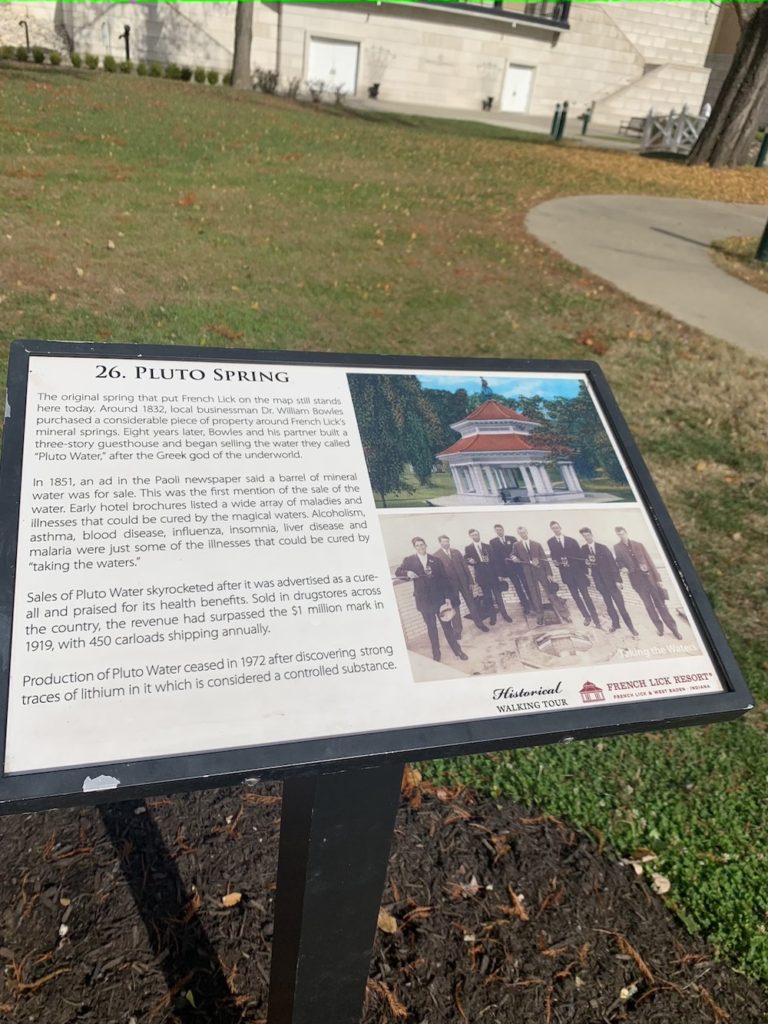
Dr. Bowles went to the Mexican war in 1846-48 and leased the French Lick House to Dr. Lane during his leave. Once the war was over Dr. Bowles did not want to renew the lease and Dr. Lane decided to move to what was called Mile Lick and build his own hotel called Mile Lick Inn. This name was chosen because the hotel was a mile away from the famous French Lick spring.
The Origins of West Baden

Dr. Lane built his first hotel in 1855 and caused intense competition between the two hotels in the neighboring towns. The West Baden Hotel had various owners and it had four separate wings named for the points on a compass. The North, West, South wings were said to be the original three wings built, and the East wing was added on June 14, 1901, by the Sinclair Family of Salem, Indiana. Mr. Lee Sinclair wanted to buy the first hotel in the West Baden Village in 1887, but there was no railroad Lane explained. “When Mr. Sinclair heard there was a railroad coming to West Baden in 1887, he thought it was the perfect way for guests to get here. So, he bought ⅔ interest in the Mile Lick Inn in 1888.” This railway was later named the Monon Railroad.
Mr. Lee Sinclair loved to cater to his guests, and in doing so he built a bicycle pony track, a Methodist church on the property right behind the hotel, a Catholic church to keep guests in West Baden, as the nearest Catholic church was in French Lick, and Mr. Sinclair did not want to tempt his guest to leave West Baden and see the French Lick Hotel. The Catholic church fell into disrepair as the site needed a lot of clear-cutting on the west hillside, which was steep and caused the foundation of the church to slide, thus forcing the church to be condemned.
However, the nearby city of DuBois, Indiana just west of West Baden had a Catholic church that was burned down and left their city without a church. “It says in history they came with horses and wagons and dismantled the church at West Baden, which was called Our Lady of Lourdes Catholic Church after the place in France (Our Lady of Lourdes Roman Catholic Church) and moved it to DuBois and rebuilt it on the site of their former burned down church. They named it St. Rayfield’s Catholic Church and it is still standing today,” Lane narrates. The Methodist Church, on the other hand, burned and the members decided it was best to build their new church in the town, which is still standing today.
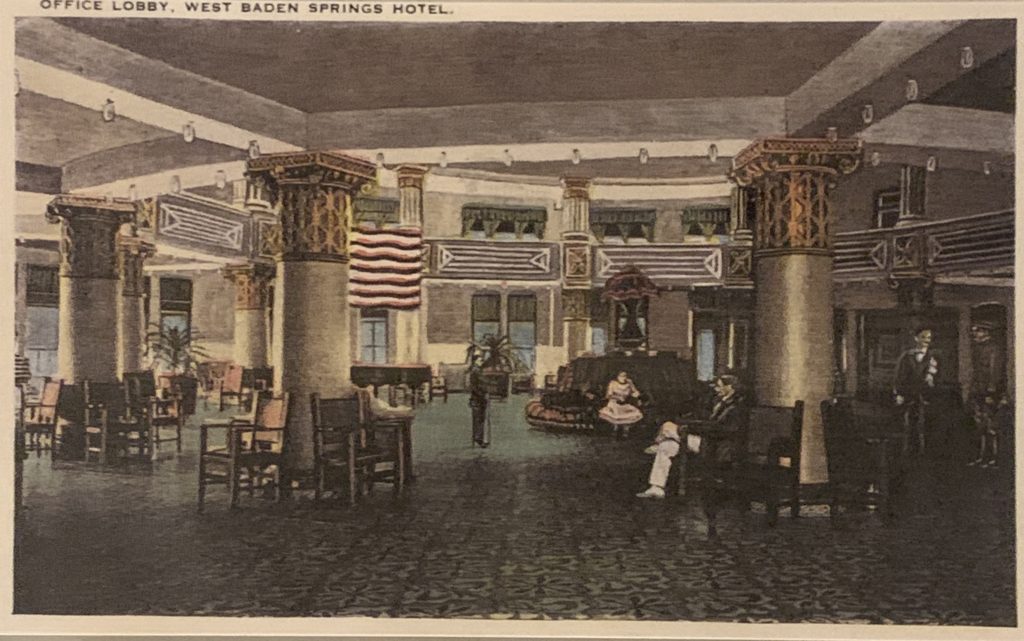
In 1901, a fire that originated in the kitchen of the hotel spread throughout the building, caused the night watchmen to alert the guests by shouting and shooting a pistol to urge them to get to the east wing. Mr. Sinclair helped to evacuate people and assisted in fighting the blaze. It took 15 minutes to clear 268 guests out of the hotel, with the help of the new fire escape in the east wing.
The following week, Mr. Sinclair decided to rebuild the hotel and hired Oliver Westcott, a bridge designer to help with the rebuild, giving him a year to complete the project. Mr. Sinclair did not want to lose too much money nor did he want his guests to go to the French Lick Hotel, so he told Westcott he would charge him $100 for each day the project was late. On the anniversary of the fire, the Sinclairs moved into their suite and entertained their guests from Chicago.
Following the fire, Mr. Sinclair advertised the only wood in this building was the wood around the doors, windows, and the ballroom. The ballroom has since been turned into suites located on the third floor. In 1902, the West Baden Hotel donned bare lightbulbs which were powered by the power plant owned and produced by Sinclair and lightbulbs remain in place today.
The West Baden Hotel closed in 1932 and became a Jesuit Seminary, then it became a private liberal arts college called Northwood Institute, and was vacant from 1983-1996. “Until the present owners, the Cook Family from Bloomington, Indiana purchased the property,” Lane explains. The Cooks are well-known preservationists in the southern part of Indiana, they have purchased both hotels for the first time in history. Collectively calling it all the French Lick Resort with the West Baden Hotel.
The atrium at the West Baden Hotel is well-known for its beauty, it is located in the center of the hotel and once held flowers and plants. Lillian Sinclair, Mr. Sinclair’s only daughter, had a gold medallion installed directly above the center of the room hoping to create a more formal atmosphere to entertain their hotel guests.
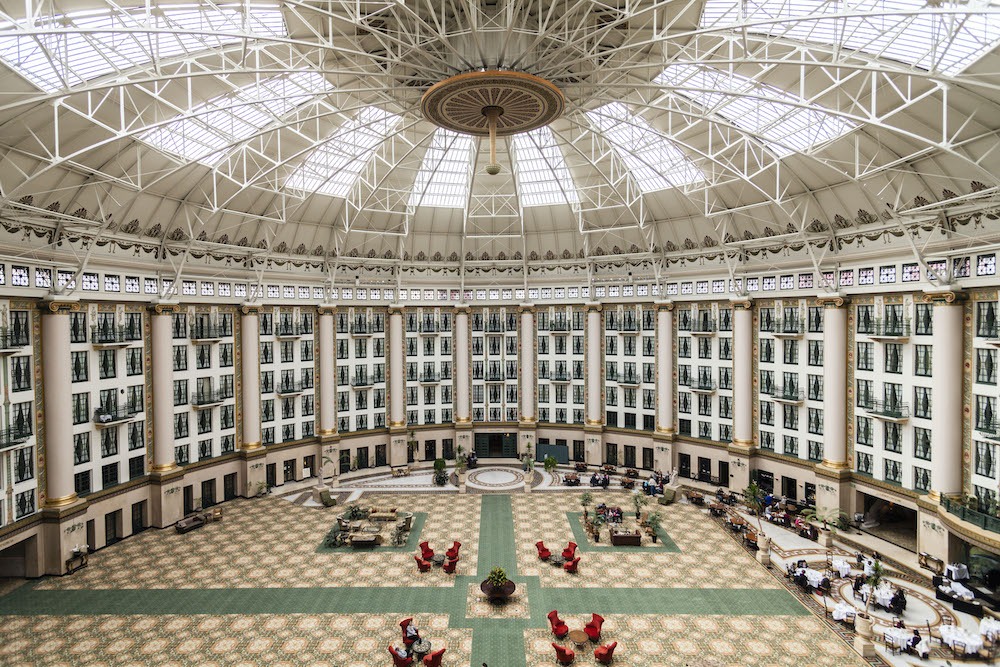
The dome of the atrium was built to expand and contract based on the weather, allowing the hotel employees to adjust the dome based on the temperature and humidity outside. Each column in the atrium has a track with four casters, similar to wheels on roller skates, that have girders that sit on top of the tracks, which allow a two-inch expansion. In the hopes to make it warmer or cooler for the plants and atmosphere for the guests.
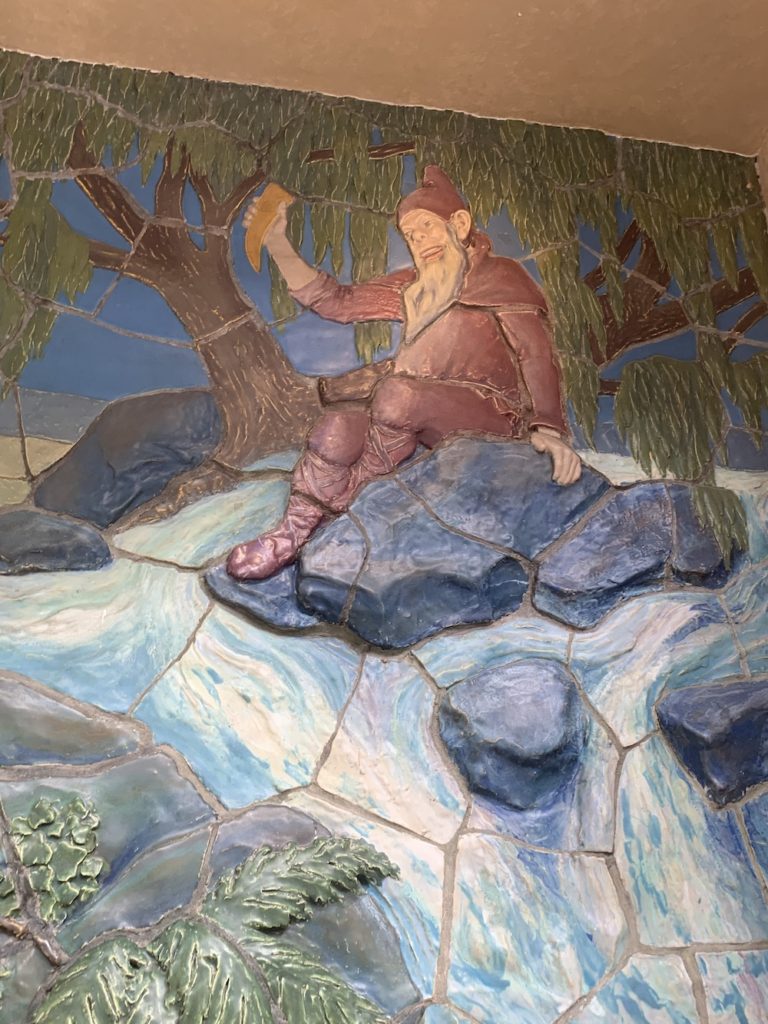
In 1991, there was a collapse of the west side of the building, because the local owner at the time removed the walls between the guestrooms, hoping to make them larger. This caused the water that had pooled on the roof and gutters to put weight on the building which caused the collapse. During this time, the building was empty and no one was harmed. “There has been a lot of rebuilding since then using structural steel to prevent history from repeating itself,” Lane confirms. The West Baden Hotel continues to rise up from each disaster in its history like a phoenix from the ashes.
10 Fun Facts About French Lick/West Baden Resorts
- In 1918 and 1919 the West Baden Hotel served as a WWI War hospital.
- The mineral water at West Baden is called sprudel water.
- In 1902 West Baden hotel produced its own electricity in his own power plant.
- There are three Greek Muses featured in the West Baden atrium: Cleo, Calliope, and Thalia.
- West Baden had four mineral springs that you could visit that were advertised to cure all diseases.
- While the West Baden hotel was once advertised as having an (untrue) 708 rooms, today it does truly have 243 rooms available.
- Greek God of the Underworld Pluto is the French Lick mascot.
- The name French Lick comes from the natural salt licks created by the hot spring in the area.
- Nashville, Tennessee was once called French Lick, TN.
- The first hotel in French Lick/West Baden, IN was built in 1845.
Present Day
Today, the West Baden hotel is a hidden gem of the Midwest and a stunning example of architecture and ingenuity. Today’s resort consisting of the French Lick Hotel, West Baden Hotel, and French Lick Casino, has dozens of amenities. At the French Lick Casino, visitors can enjoy slots, table games, sports betting, and fine dining options. The Casino is home to the exclusive Lightning Lounge, which features the best selection of Lighting and Dragon Link games in Indiana including “Tiki Fire, Sahara Gold, Moon Race, Panda Magic, and Magic Pearl.”
In addition to the high-tech slot machines, there are 11 table games to choose from like Blackjack, Craps, Roulette, and Three Card Poker. It’s the glitz and glamor of high-stakes Vegas-style gambling with all of the comfort and quaint charm afforded by French Lick, Indiana’s quiet rolling landscapes.
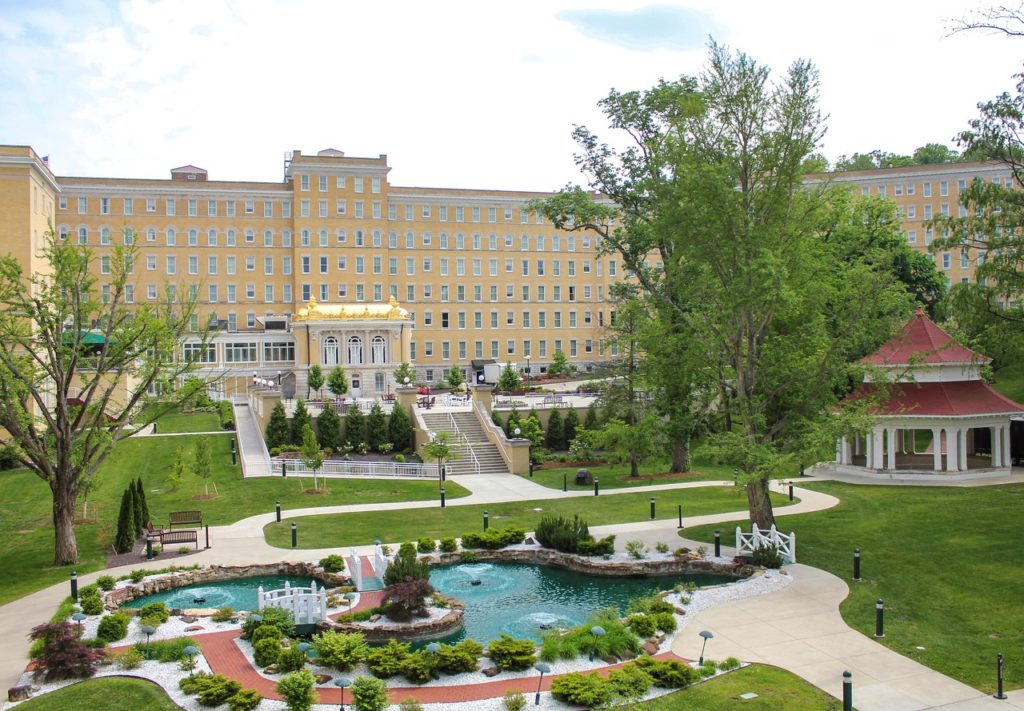
There are award-winning golf courses to choose from at the French Lick/West Baden resorts. The first is the Pete Dye Course, which hosted the Senior PGA Championship in 2015 and was designed by Hall of Fame architect Pete Dye himself. Located on one of Indiana’s highest elevation points, the Pete Dye Course boasts 40 miles of panoramic views with narrow fairways and challenging terrain, including three man-made lakes and even “volcano bunkers.”
The Donald Ross Course was restored in 2007 and originally constructed by famed architect Donald Ross back in 1917. The course is a par 7 and includes 80 of Donald Ross’s trademark bunkers and continues to be a GolfWeek top-rated pick since 2011.
If visitors are looking for a family-friendlier option, the Valley Links Course is open for golfers of all ages and skill levels. This course is a nine-hole, walkable par-36 course that includes two sets of tee markers for both beginners and intermediate golfers and was completely designed with fun for the whole family in mind. If all of these options are exhausted, the Sultan’s Run is the fourth and final available course at French Lick Resort. A scenic landscape with a waterfall behind the 18th green, Sultan’s Run is definitely a photo-worthy place to stop and play.
Both French Lick and West Baden Resort were originally built with health and wellness in mind, and their onsite spas continue that tradition. The Spa at the French Lick Resort offers high-class traditional American treatments, while The Spa at West Baden incorporates European inspired relaxation options. Both offer experiences like aromatherapy massages, healing facials, and more, but visitors to either spa should definitely request the signature Pluto mineral bath for an authentic French Lick/West Baden experience.

The West Baden Hotel has three wings, a spa wing, the spring wing — which is near the Pluto Spring and is still there and flowing, and the garden wing rounding out the hotel. Unlike the French Lick Hotel, the West Baden Hotel was hit hard by the Great Depression as the hotel was already vacant. Whereas the French Lick Hotel has only closed for a year for restoration purposes.
However, since the West Baden Hotel was already vacant, this made it even easier to start the restoration process. The Cook family spent over $650 million dollars restoring both hotels and constructing the new casino. As part of that restoration, the original stones from one of the first French Lick Hotel were repurposed to create the tunnel that leads to the various to Pluto’s Bowling Alley and Pizzeria.
When traveling between these exciting sites for fun and relaxation, visitors can take advantage of the trolley service offered by the hotels. Originally constructed in 1903, the electric trolley service carried 250,000 visitors in 1916. Billed as the “world’s shortest trolley ride,” the streetcar goes an entire mile into downtown French Lick and back.
Unfortunately, in 1919, the rising popularity of the automobile signified the end of the trolley. In 1987 the Indiana Railway Museum and Railway Historian Alan Barnett began working on restoring the trolley service, then in 2014, their dream became a reality. Today, resort guests can hop on the trolley between noon and 8:00 PM 365 days a year and experience the same thrilling ride that visitors did almost 100 years ago.
The MCAA is very excited to be hosting this year’s Midyear Meeting at the French Lick Resort. The rich history of these locations coupled with the beautiful masonry work both inside and outside will serve as an elegant backdrop as MCAA members mix and mingle during networking events like Hand-On Speed Dating, soak up the landscape on the golf course, or relax in the spa.
You can enjoy time with old friends, have conversations with new ones, and experience the community enjoyed by members of the masonry industry nationwide. If you’re interested in attending this year’s Midyear Meeting, go to www.midyear.masoncontractors.org or call 800.536.2225.
Larry Bird isn’t the only famous thing out of French Lick Indiana. From the sulfur “healing” springs to the vast hotels rich with fun facts and history, there is something for everyone when visiting this hidden American Treasure. So if you are looking to explore someplace new this summer and are up for a road trip, be sure to visit French Lick and West Baden Indiana, you will not be disappointed. We would like to thank the Historian of the French Lick Resort, Jeffrey Lane, for providing us with such a dedicated history.